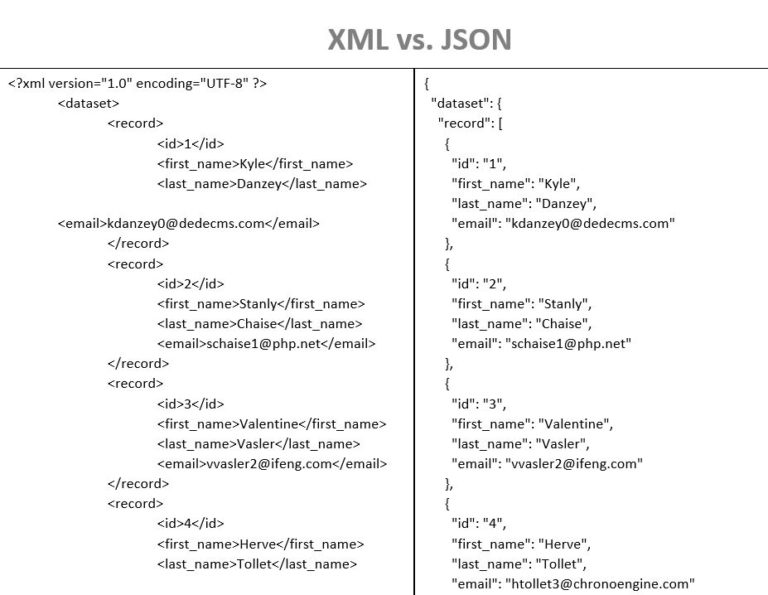Convert XML to CSV Like a Pro Essential Tools & Methods

XML files are known for their flexibility when it comes to representing structured data. XML uses tags to define elements and attributes to provide additional information about those elements. This hierarchical structure allows for complex relationships between different data entities.
XML conversion to JSON
You can use CSV files most typically for importing and exporting vital data to and from your database, such as customer or order data. Furthermore, you may open CSV files in a variety of spreadsheet tools, including Microsoft Excel and Google Spreadsheets. CSV stands for “Comma Separated Values,” which signifies that the “columns” are separated by a delimiter in a standard text file. It is still a widely common file format for all sorts of data. No-code XML converters let you convert XML files to CSV, Databases, or Excel without having to know how to code.
XML Data File Example
You do not need to care too much about your spreadsheet application either. Comma-separated values (more commonly known as the CSV) are a very popular format that is used heavily for data storage and manipulation tasks. This is the go-to format for many scientific and business operations. Additionally, I recommend automating XML validation in development and deployment to ensure documents conform to the schema and catch errors early for increased reliability. For Java-based projects, JAXB can programmatically validate XML files using an XSD schema during your development and runtime. Overall, CSV is compact and simple, and JSON has a balance of structure and readability.
List Application of Artificial Intelligence

Its key-value structure aligns with JavaScript’s object syntax. JSON perfectly handles nested configuration files for managing dynamic Node.js applications. Because of its data validation and security, XML is used widely in healthcare for recordkeeping and the exchanging, integrating, and, and sharing of electronic health information.
The XML Import Tool in Excel makes it easy to turn XML data into a structured, tabular format that can be used in an Excel spreadsheet. This tool makes working with XML files easier by automatically mapping XML elements to Excel rows and columns. This lets users change and analyse the data using functions they are already familiar with from spreadsheets. XML is widely used in various domains such as web development, data storage, configuration files, and data interchange formats. It provides a flexible and extensible format for representing structured data that can be easily processed and interpreted by both humans and machines. Extensible Markup Language (XML) is a programming language that you may use for a variety of purposes.
- Understanding these key components makes working with Twitter’s data easier if you’re using it in your own projects.
- The plain text format of CSV makes it easy for humans to understand and edit the data directly using a text editor or spreadsheet software.
- Perfect for professionals and developers, our tool ensures accuracy, saves time, and enhances efficiency in managing data.
- While we can still read it, it’s not as self-explanatory as CSV.
Pro Tips for using JSON
CSV stands for comma-separated values, and it is a plain text format that stores data in rows and columns, separated by commas or other delimiters. CSV is simple, universal, and easy to read and write by humans and machines. It is widely supported by many software and programming languages, such as Excel, Python, and R. CSV is ideal for data analysis when you have tabular data that is not too complex or nested, and when you want to import or export data quickly and efficiently.
Both are reasonably space-efficient, and both have a lot of flexibility for handling complex data. Connect and share knowledge within a single location that is structured and easy to search. You can exchange csv vs xml a piece of data that is simply a record of information in its raw form between two systems using JSON. With REST winning the race against SOAP, JSON found its purpose and set the record straight against XML.
Not surprisingly, I find myself using it more and more, internally and externally. You can easily traverse through XML data even when you have complex data. If your data is hierarchical, or complex, then you should go for XML or JSON or even YAML. JSON has got lot of attention these days, and parser is available in any language. Having been in the industry for 20 years, the formerly Yet Another Markup Language (it’s now YAML Ain’t Markup Language) took its own sweet time to get familiar in the tech world. But these days, it has become the favourite for coffee break past time.
While the CSV file format offers numerous advantages, it also has potential security risks to be mindful of. One of the most notable vulnerabilities is CSV Injections (also known as Formula Injections). CSV Injection is a security vulnerability that occurs when a CSV file containing malicious input is interpreted by a spreadsheet program (such as Microsoft Excel or Google Sheets). Specifically, these attacks can be executed when the CSV data includes entries that are interpreted as formulas by these spreadsheet programs. Applications typically need to receive CSV files in a particular structure (and with correctly entered data) to avoid unexpected behavior or invalid analyses.
Whether you’re managing simple flat data or complex data structures, choosing the right format will streamline your workflow and help you meet your project goals. You may want to use XSD with an Oracle database, where an XSD schema can be registered and then used to validate XML documents against itself. This article, “Complete Oracle XSD Guide—Register XSD & Validate XML” provides step-by-step examples and sample code on utilizing XSD in Oracle databases. Although XML is a better choice for applications with systems designed to work together or in which schema enforcement is crucial due to its self-describing structure and strong validation. Finally, if you are active in web development, you’ll encounter the XML to JSON conversion.

 We use cookies to optimize our website and our service.
We use cookies to optimize our website and our service. 
